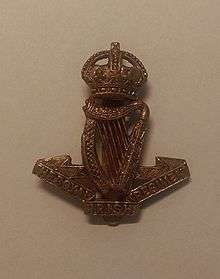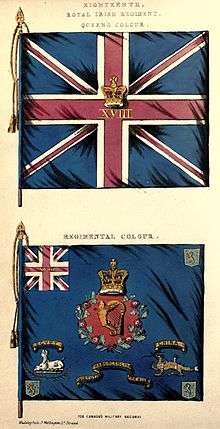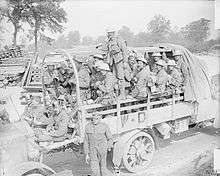Royal Irish Regiment (1684–1922)
| 18th Regiment of Foot 18th (Royal Irish) Regiment of Foot Royal Irish Regiment | |
|---|---|
 Royal Irish Regiment Cap Badge | |
| Active | 1684–1922 |
| Country |
|
| Branch |
|
| Type | Infantry |
| Role | Line infantry |
| Size |
2 Regular battalions |
| Garrison/HQ | Kickham Barracks, Clonmel |
| Nickname(s) | The Namurs, Paddy's Blackguards |
| Motto(s) | Virtutis Namurcensis Praemium (Reward for Valour at Namur) |
| March | Quick: Garry Owen |
| Disbanded | 1922 |
The Royal Irish Regiment, until 1881 the 18th Regiment of Foot, was an infantry regiment of the line in the British Army, first raised in 1684. Also known as the 18th (Royal Irish) Regiment of Foot and the 18th (The Royal Irish) Regiment of Foot, it was one of eight Irish regiments raised largely in Ireland, its home depot in Clonmel.[1] It saw service for two and a half centuries before being disbanded with the Partition of Ireland following establishment of the independent Irish Free State in 1922 when the five regiments that had their traditional recruiting grounds in the counties of the new state were disbanded.[2]
Formation

The regiment was formed in 1684 by the Earl of Granard from independent companies in Ireland.[3] In 1695, the regiment became known as the Royal Regiment of Ireland due to its performance at the Siege of Namur in 1695 under the direction of King William III.[3]
Early history
The regiment saw action at the Siege of Kaiserswerth in 1702,[4] the Battle of Schellenberg in July 1704 and the Battle of Blenheim in August 1704 during the War of the Spanish Succession.[5] It also took part in the Battle of Ramillies in May 1706,[6] the Battle of Oudenarde in July 1708[7] and the Battle of Malplaquet in September 1709.[8]
The regiment also won the right to display the King's arms on their colours along with the harp and crown. The regiment was sent to Gibraltar, which was being blockaded by Spain, in 1727.[9] In 1751, the regiment was officially ranked as the 18th Regiment of Foot – although it was older than all but six other line regiments, it had not been placed on the English establishment until 1689, lowering its precedence.[3]
The regiment was in Ireland during the majority of the Seven Years' War and was ordered to America on 1 January 1767. The regiment arrived at Philadelphia on 11 July 1767 under the command of Lieutenant Colonel John Wilkins.[10] The regiment remained at Philadelphia, although a small detachment was sent to Fort Pitt later that summer. The majority of the regiment under Wilkins was ordered to Illinois in early 1768 and remained in Illinois until April 1772 when Fort de Chartres was abandoned. A small detachment under Captain Hugh Lord, remained at Fort Gage (Kaskaskia), Illinois until May 1776 when it was ordered to Detroit in anticipation of an American attack on that post. The rest of the regiment was present in Boston, where the grenadier company participated in the Battle of Lexington and Battle of Concord in April 1775 during the American Revolutionary War[11] as well as the Bunker Hill in June 1775, its first formal combat in more than 50 years.[12] A detachment of the Royal Irish along with a detachment of the Royal Fencible Americans were sent to Penobscot, Maine to cut wood for the garrison in the early Autumn 1775.[13] The eight companies at Boston were drafted into other regiments in December 1775 and the detachment at Detroit was drafted into the 8th (The King's) Regiment of Foot in July 1776.[13]
In 1783 there was a mutiny by 500 mainly Irish soldiers in the 104th Regiment based at Fort George in Guernsey. Both the regiment (the Royal Irish) and the Guernsey Militia turned out with 6 pieces of artillery. Volleys of shots were fired by the rebels, but when the militia outflanked the rebels, they surrendered. The Government of Guernsey gave a public thanks to the regiment and militiamen, awarding them 100 guineas.[14] The regiment returned to Gibraltar later in the year, where it remained until the Siege of Toulon in 1793 during the French Revolutionary Wars.[15] The regiment also saw action at the Battle of Alexandria in March 1801.[16] The 1st Battalion served in Jamaica and the 2nd Battalion served in Curaçao during the Napoleonic Wars.[17]
19th century

During the First Opium War in China, the regiment next saw action at the Capture of Chusan in July 1840, Battle of Canton in May 1841,[18] Battle of Amoy in August 1841,[19] Second Capture of Chusan in October 1841, Battle of Ningpo in March 1842,[20] Battle of Tzeki in March 1842, Battle of Woosung in June 1842, and Battle of Chinkiang in July 1842.[21] It took part in the Siege of Sevastopol during the Crimean War; Captain Thomas Esmonde was awarded the Victoria Cross for saving a party of colleagues from a fire of shell and grape.[22] The regiment also took part in the Second Anglo-Afghan War.[23]
The 2nd Battalion, which was re-formed on 18 September 1857, began to arrive in New Zealand from 4 July 1863 and served in the Waikato and Taranaki campaigns of the New Zealand Wars.[23] Captain Hugh Shaw won the Victoria Cross when he rescued wounded soldiers during a skirmish at Nukumaru near Whanganui.[24]
In 1881 as part of the Childers Reforms the regiment became the Royal Irish Regiment, and served as the county regiment of Tipperary, Waterford, Wexford and Kilkenny.[25] Its garrison depot was at Kickham Barracks in Clonmel.[26] Militarily, the whole of Ireland was administered as a separate command within the United Kingdom with Command Headquarters at Parkgate (Phoenix Park) Dublin, directly under the War Office in London.[27] The 2nd Battalion saw action in Egypt during the Anglo-Egyptian War in 1882.[23] The 1st Battalion played an important role at the Battle of Slabbert's Nek in July 1900 during the Second Boer War.[28]
First World War

Regular Army
The 1st Battalion landed at Le Havre as part of the 82nd Brigade in the 27th Division in December 1914 for service on the Western Front but moved to Salonika in November 1915.[29] The 2nd Battalion landed at Boulogne-sur-Mer as part of the 8th Brigade in the 3rd Division in August 1914 for service on the Western Front but was almost completely destroyed at the Battle of La Bassée in October 1914 with many men being taken as prisoners of war.[29] The battalion was re-formed in October 1914 and, as part of the 22nd Brigade in the 7th Division saw further action at the Battle of the Somme, when it was involved in capturing three miles of the German frontline trenches, in Autumn 1916.[30]
The 3rd (Reserve) Battalion, largely made up from local Dubliners, were the first British army troops to attack the Irish rebels during the Easter Rising: the rebels were fighting to end British rule in Ireland and to establish the Irish Republic in Dublin.[31] Eight of the Royal Irish Regiment were killed and sixteen more wounded.[32] Some of these are buried in Grangegorman Military Cemetery. A Royal Irish Regiment officer reported that "they regarded, not unreasonably, everyone they saw as an enemy, and fired at anything that moved".[33]
New Armies
The 5th (Service) Battalion (Pioneers) landed in Suvla Bay as pioneer battalion for the 10th (Irish) Division in August 1915 but moved to Salonika in September 1915.[29] The 6th (Service) Battalion landed at Le Havre as part of the 47th Brigade in the 16th (Irish) Division in December 1915 for service on the Western Front.[29] The 7th (South Irish Horse) Battalion was formed in France as part of the 49th Brigade in the 16th (Irish) Division from the dismounted 1st and 2nd South Irish Horse in September 1917.[29]
Disbandment
Due to substantial defence cuts and the establishment of the Irish Free State in 1922, it was agreed that the six former Southern Ireland regiments would be disbanded,[34][35] including the Royal Irish Regiment. On 12 June, five regimental colours were laid up in a ceremony at St George's Hall, Windsor Castle in the presence of HM King George V.[36] The six regiments were then all disbanded on 31 July 1922.[3] With the simultaneous outbreak of the Irish Civil War conflict some thousands of their ex-servicemen and officers contributed to expanding the Free State government's newly formed National Army. They brought considerable combat experience with them and by May 1923 comprised 50 per cent of its 53,000 soldiers and 20 per cent of its officers.[37]
Battle honours

The battle honours of the regiment were:[3]
- Early Wars: Namur 1695, Blenheim, Ramillies, Oudenarde, Malplaquet, Egypt, China, Pegu, Sevastopol, New Zealand, Afghanistan (1879–80), Tel-el-Kebir, Egypt 1882, Nile (1884–85), South Africa (1900–02)
- The Great War: Mons, Le Cateau, Retreat from Mons, Marne 1914, Aisne 1914, La Bassée 1914, Ypres 1915 '17 '18, Gravenstafel, St Julien, Frezenberg, Bellewaarde, Somme 1916 '18, Albert 1916 '18, Bazentin, Delville Wood, Guillemont, Ginchy, Messines 1917, Pilckem, Langemarck 1917, St. Quentin, Rosières, Arras 1918, Drocourt-Quéant, Hindenburg Line, Canal du Nord, St Quentin Canal, Beaurevoir, Cambrai 1918, Courtrai, France and Flanders 1914–18, Struma, Macedonia 1915–17, Suvla, Landing at Suvla, Gallipoli 1915, Gaza, Jerusalem, Tell 'Asur, Megiddo, Nablus, Palestine 1917–18
Victoria Crosses
The following members of the Regiment were awarded the Victoria Cross:
- Captain Thomas Esmonde, Crimean War
- Captain Hugh Shaw, New Zealand Wars
- Private John Barry, Second Boer War
- Private (Acting Lance-Corporal) Frederick George Room, First World War
Great War Memorials
- Irish National War Memorial Gardens, Dublin.
- Island of Ireland Peace Park Messines, Belgium.
- Ulster Tower Memorial Thiepval, France.
- Menin Gate Memorial Ypres, Belgium.
Colonels
The colonels of the regiment were:[3]
- Earl of Granard's Regiment of Foot
- 1684–1686: Lt-Gen. The 1st Earl of Granard
- 1686–1688: Col. Viscount Forbes (The 2nd Earl of Granard from 1696)
- 1688–1689: Col. Sir John Edgeworth
- 1689–1692: Col. The 4th Earl of Meath
- 1692–1705: Major-Gen. Frederick Hamilton
- Royal Regiment of Ireland - (1695)
- 1705–1712: Lt-Gen. Richard Ingoldsby
- 1712–1717: Brig-Gen. Robert Stearne
- 1717–1732: Brig-Gen. William Cosby
- 1732–1735: Brig-Gen. Sir Charles Hotham, 5th Baronet
- 1735–1742: Major-Gen. John Armstrong
- 1742–1747: Gen. Sir John Mordaunt KB
- 1747–1762: Lt-Gen. John Folliott
- 18th (The Royal Irish) Regiment of Foot - (1751)
- 1762–1794: Gen. Sir John Sebright, 6th Baronet
- 1794–1811: Gen. Sir James Pulteney, 7th Bt [38]
- 1811–1832: Gen. The 2nd Earl of Donoughmore (he was styled as The 1st Baron Hutchinson up until 1825), KB
- 1832–1850: Gen. The 5th Baron Aylmer, GCB
- 1850–1877: F.M. Sir John Forster FitzGerald GCB
- 1877–1882: Lt-Gen. Clement Alexander Edwards CB
- The Royal Irish Regiment - (1881)
- 1882–1886: Gen. Sir Alexander Macdonell KCB
- 1886–1889: Gen. Sir Richard Denis Kelly KCB
- 1889–1895: Gen. George Frederick Stevenson Call CB
- 1895: Lt-Gen. Walter McLeod Fraser
- 1895–1897: Lt-Gen. Sir Henry Marshman Havelock-Allan, Bt, VC, GCB
- 1897–1918: Major-Gen. Charles Frederick Gregorie, CB
- 1918–1922: Major-Gen. John Burton Forster CB
References
- ↑ Harris, Appendix II, pp. 216–217: Table listing the eight Irish Regiments of the British Army July 1914, their Depots, Reserve Bns., and local Militia.: Royal Irish Regiment Depot Clonmel, Royal Inniskilling Fusiliers Depot Omagh, Royal Irish Rifles Depot Belfast, Royal Irish Fusiliers (Princess Victoria's) Depot Armagh, Connaught Rangers Depot Galway, Leinster Regiment Depot Birr, Royal Munster Fusiliers Depot Tralee, Royal Dublin Fusiliers Depot Naas.
- ↑ Murphy, p. 30 quote: "Following the treaty that established the independent Irish Free State in 1922, it was decided to disband the regiments that had their traditional recruiting grounds in southern Ireland: The Royal Irish Regiment; The Connaught Rangers; The Prince of Wales' Leinster Regiment; The Royal Munster Fusiliers; The Royal Dublin Fusiliers; The South Irish Horse"
- 1 2 3 4 5 6 "The Royal Irish Regiment". Regiments.org. Retrieved 9 July 2016.
- ↑ Cannon, p. 20
- ↑ Cannon, p. 26
- ↑ Cannon, p. 30
- ↑ Cannon, p. 33
- ↑ Cannon, p. 35
- ↑ Cannon, p. 42
- ↑ Cannon, p. 47
- ↑ Cannon, p. 48
- ↑ Cannon, p. 49
- 1 2 Baule, p. 25
- ↑ Duncan, p. 163
- ↑ Cannon, p. 50
- ↑ Cannon, p. 58
- ↑ Cannon, p. 61
- ↑ Cannon, p. 69
- ↑ Cannon, p. 70
- ↑ Cannon, p. 72
- ↑ Cannon, p. 74
- ↑ The London Gazette: no. 22043. p. 3194. 25 September 1857. Retrieved 29 March 2015.
- 1 2 3 "Royal Irish Regiment". National Army Museum. Retrieved 9 July 2016.
- ↑ The London Gazette: no. 23044. p. 6005. 28 November 1865. Retrieved 23 December 2009.
- ↑ The London Gazette: no. 24992. pp. 3300–3301. 1 July 1881.
- ↑ "The Kickham Army Barracks Development Proposal" (PDF). University College Cork. Retrieved 11 November 2014.
- ↑ Harris, pp. 2–3
- ↑ "Royal Irish Regiment". Anglo-Boer War. Retrieved 9 July 2016.
- 1 2 3 4 5 "Royal Irish Regiment". The Long, Long Trail. Retrieved 9 April 2016.
- ↑ "Irish Soldiers in the Battle of the Somme". Department of the Taoiseach. Retrieved 9 April 2016.
- ↑ Caulfield, pp. 76–80
- ↑ Sinn Féin Rebellion Handbook. Irish Weekly Times. 1917. Retrieved 16 November 2010.
- ↑ McGarry, p. 184
- ↑ Army Order 78/1922
- ↑ Murphy, p. 30
- ↑ Harris, p. 209
- ↑ Cottrell, p. 23
- ↑ The London Gazette: no. 13627. p. 180. 25 February 1794. Retrieved 6 December 2009.
Sources
- Baule, Steven (2013). Protecting the Empire's Frontier: Officers of the 18th (Royal Irish) Regiment of Foot During Its North American Service, 1767–1776. (PDF). Ohio University Press. ISBN 9780821420553.
- Cannon, Richard (1848). Historical Record of the Eighteenth, or Royal Irish Regiment of Foot. London: Parker, Furnivall and Parker.
- Caulfield, Max (1995). The Easter Rebellion: The Outstanding Narrative History of the 1916 Rising in Ireland. Roberts Rinehart Publishers. ISBN 978-1570980428.
- Cottrell, Peter (2008). The Irish Civil War 1922–23. Osprey Publishing. ISBN 978-1-84603-270-7.
- Duncan, Jonathan (1841). The History of Guernsey with Occasional Notices of Jersey, Alderney and Sark and biographical sketches. Longman.
- Harris, Major Henry E. D. (1968). The Irish Regiments in the First World War. Mercer Press Cork. ISBN 978-0853420729.
- McGarry, Fearghal (2010). The Rising: Ireland, Easter 1916. Oxford University Press. ISBN 978-0-19-280186-9.
- Murphy, David (2007). Irish Regiments in the World Wars. Osprey Publishing. ISBN 978-1846030154.
Further reading
- Geoghegan, Brigadier-General Stannus, C.B. (1927). The Campaigns and History of the Royal Irish Regiment Volume 2 from 1900 to 1922. William Blackwood and Sons Ltd Edinburgh and London. ISBN 978-1847347473.
- Gretton, Lieutenant Colonel G. le M. (1911). The Campaigns and History of the Royal Irish Regiment From 1684 to 1902. William Blackwood and Sons Ltd Edinburgh and London.
External links
- Department of the Taoiseach: Irish Soldiers in the First World War
- Royal Irish Regiment in America, 1767–1776
